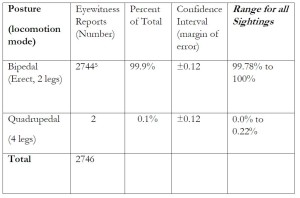The following table, indicating bigfoot mode of locomotion, was compiled from data from John Green’s sasquatchdatabase.com. I’ve excerpted several paragraphs of analysis from Bigfoot in Evolutionary Perspective to put the data in greater context. For evolutionary classification purposes, this data set carries the greatest weight and implication.
Table 4. 1 Bigfoot Posture, or Mode of Locomotion, according to Eyewitness Testimony

Excerpted from Bigfoot in Evolutionary Perspective: The Hidden Life of a North American Hominin:
“The largest eyewitness data sample in Green’s database is bigfoot posture, or the mode of locomotion, either bipedal or quadrupedal, utilized by the bigfoot (Table 4.1). The data set is large (2,746 observations) and the proportion of eyewitnesses testifying that the bigfoot moved bipedally is so extraordinarily high (99.9%) and the resulting margin of error so low that firm conclusions can be drawn that can be applied not only to eyewitness sightings, but the entire bigfoot population at large: bigfoot is an obligate biped and 100% of the population uses this mode of locomotion. While such a statement must seem anticlimactic to any layman who has an interest in the subject and takes this for granted, from an anthropological and scientific perspective it is profound. When a Louis, Mary, or Richard Leakey, or a Donald Johanson or any paleoanthropologist discovers a fossil that potentially belongs in the human ancestral tree, bipedalism, or walking upright on two legs, is the overriding trait that determines hominin status and places the fossil somewhere in the hominin lineage. It may not be a direct link to the Homo family or Homo sapiens, and may be an offshoot species, like one of the robust australopithecines, but it shared a common ancestor with Homo at some point in the distant past from which it derived the ability to walk upright. Of course, bigfoot is not a fossil, though fossilized remains may be recovered at some future date in North America, Asia, or potentially even Africa, though these may be of an earlier ancestral form and will likely remain unrecognized as ancestral to bigfoot. Nonetheless, living or extinct, the same methodology must prevail. Since it is bipedal, bigfoot belongs in the hominin lineage where shared ancestry has conferred it the ability to walk upright. Other evolutionary scenarios, where bipedalism has arisen convergently in bigfoot or a potential bigfoot ancestor, like Gigantopithecus, are improbable at best, and fail any in-depth analysis, despite this being the consensus scenario among bigfoot researchers (see Chapter 6).” (p. 56-57).
“The statistical analysis also refutes a contention proposed by some bigfoot researchers that bigfoot is equally adept at moving quadrupedally as it is bipedally, or at least utilizes this form of locomotion in conjunction with bipedalism or in preferred instances. Instances of quadrupedal movement are extremely rare, and while there are five other instances of adult sasquatches described as being on “all fours” in the database,[1] two were eating in this position, another was on its knees peering around brush, and another was squatting in the road with road kill before it leaped up; none of these suggest anything other than a temporary stance being assumed. The other report shows a reversion to bipedal locomotion, suggesting a preference for erect, two legged walking or running.[2] The conclusion can only be that bigfoot is an obligate biped, no different than Homo sapiens in this regard. Moving about on two feet and two hands for any length of time would be inefficient, taxing, awkward, and, ultimately, anatomically inconsistent. Bigfoot must lack the anatomical structures in the shoulders, wrists, and hands that, for example, allow chimpanzees, gorillas, and bonobos the ability to knuckle walk for long distances and makes them obligate quadrupeds. Unlike the flexible wrists of humans, each of these species are characterized by stiff wrists which provide the necessary support when knuckle walking. Gorillas naturally walk with locked wrists while the wrists of bonobos and chimpanzees have bony features that prevent too much bending (Duke University, 2009). While there may be rare instances of a bigfoot moving quadrupedally, these are likely for evasive purposes, ambush purposes, responses to terrain, or other temporary purposes, even the result of injury. Of the two incidents of potential quadrupedal movement in the database,[3] one sighting gives next to no information, while the other suggests a possible bigfoot moving on “all fours, but placing very little weight on (the) front limbs, (the) gait peculiar, one side then the other.” Though the latter was described as “very fast,” it hardly suggests efficient movement.” (p 57-58)

References:
Duke University. (2009, August 11). Bipedal Humans Came Down From The Trees, Not Up From The Ground. ScienceDaily.
[1] Sasquatchdatabase.com incidents #991104, 991626, 991236, 1001248, 1000193. Including these incidents as quadrupedal locomotion will not meaningfully change the statistical calculations in table 4.1, or the conclusion that bigfoot is an obligate biped. If these are misidentifications errors (bears mistaken for a bigfoot), it suggests an eyewitness misidentification error rate of substantially less than 1% (0.1- 0.5%). (7 incidents, 0.3 percent of total, ± 0.2 confidence interval, 0.1%- 0.5% = range for all sightings.)
[2] Sasquatchdatabase.com incident #1000193.
[3] Sasquatchdatabase.com incidents #992104, 1001517. 992104 gives almost no details to decipher if the bigfoot was simply seen in a four footed posture or was moving quadrupedally. Nonetheless, I have counted it as potential quadrupedal movement.
Copyright 2016-20 T. A. Wilson. All rights reserved.